Medieval Masculinities: The Myths, the ‘Modern’ World and the Movies
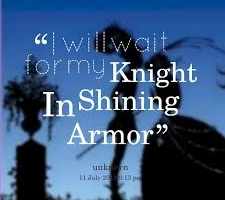
Kathleen Parker, writing for the Post-Tribune, a Chicago Sun-Times Publication, writes “A Little Bit of Chivalry Shouldn’t Hurt Anyone.” The question she addresses is one that might not have been discussed in the Middle Ages: issues of consent in drunken situations. However, her argument that “the stronger of the two has the moral responsibility to protect the weaker,” is one centuries old. She closes with this retort, “This presumes that men should be chivalrous towards women, a concept not much in vogue these days. But worse than an old-fashioned idea is a modern state that believes it should review with whom and how you conduct your sex life.” The idea of chivalry has been up for debate for centuries, from scholars who argue whether or not it actually existed, to feminists arguing whether or not it fits an egalitarian society.
Regardless of differing opinions on chivalry, it is unquestionably tied up in conceptions of masculinity and in that nebulous concept of “The Middle Ages.” Today, when we think of the Middle Ages, we think of knights errant fighting creatures or evil men, fantastic feats of arms, damsels in distress, chivalry, and the Arthurian legend. While the actual Middle Ages were far from this portrait of an orderly world, the legends surrounding King Arthur have remained constant. For a civilization that questions chivalry, masculinity and men’s roles in society, our dreams of King Arthur have changed little. We modify ancient stories such as, for Americans, Thanksgiving, to bring them more in time with an allegedly ‘modern’ world. But the treatment of masculinity has changed surprisingly little from the time of Chretien de Troyes and Thomas Malory to our 21st century.
It is, in fact, impossible to draw a ‘then-and-now’ portrait of our past and our present, especially in regard to masculinity. We have not turned away entirely from a society ordered by the patriarchy. But we do try – as this discussion about chivalry mentioned earlier demonstrates. However, Kathleen Parker’s arguments also demonstrate that we have yet to debunk the myth of knights in shining armor. We depend on men’s physical strength and ‘virtue’ (though it may be better termed common decency in today’s society) especially concerning women, and the actions they take with their fellow men to mediate and moderate our world. To better understand attitudes toward masculinity, this paper will examine characters portrayed in film and their counterparts in the Arthurian Legends of Chretien de Troyes and Thomas Malory.
The Best Knight that Ever Lived: Examining Masculinity in Arthurian Legends
As Jeffrey Jerome Cohen aptly observes in “Masoch/Lancelotism,” the meaning of the words “masculinity” and “femininity” are social constructs. The treatment of masculinity in the Arthurian legend, however, as this paper will go on to argue, is one which greatly influences our current perceptions of masculinity. Cohen writes that, “masculinity, for example, finds one of its most potent medieval realizations in the construction of heroism, a gender formulation with important social implications throughout the Middle Ages” (233). But heroes in the Middle Ages and in the Arthurian legend had very specific sets of skills. First, physical prowess was necessary, as most of the heroic activities involved slaying enemies or competing in tournaments. Secondly, no hero would be complete without a woman he loved. This tenet of heroism and thereby masculinity takes for granted our heroes’s heterosexuality. Thirdly, the hero must be in service of something or someone greater than himself. In many cases, this “something greater” revolves around King Arthur or Christianity. While King Arthur himself is the most powerful figure in the Arthurian legend in terms of political power, the myths of Camelot largely ignore him. Instead we are presented with a host of knights – Lancelot, Tristram, Gawaine, and Percival among them – who exemplify knightly virtues and become paragons of masculinity. The concept of masculine heroism that Cohen discusses can be summed up in the character of Lancelot in the Arthurian legend.
In Thomas Malory’s Morte D’Arthur, the following description is given of Lancelot:
“Soon after, all the knights of the Table Round resorted unto the king, and made many jousts and tournaments, and some increased so in arms and worships that they passed all their fellows in prowess and noble deeds, and that was well proved on many; but in especial it was proved on Sir Launcelot du Lake, for in all tournaments and jousts and deeds of arms, both for life and death, he passed all other knights, and at no time he was never overcome but if it were by treason or enchantment. Wherefore Queen Guinevere had him in great favour above all other knights, and in certain he loved the queen again above all other ladies and damosels of his life, and for her he did many deeds of arms” (31).
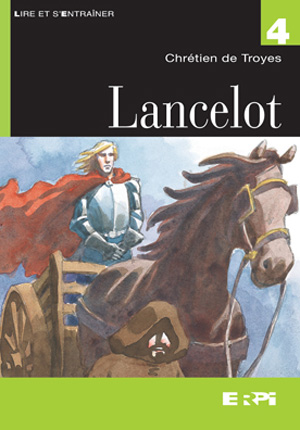
The above introduction to Lancelot clearly portrays all the virtues of knighthood and masculinity. First, service to a great king is necessary, and although Arthur is only hinted at, clearly Lancelot is favored. Secondly, Lancelot has proved himself physically, having “passed all other knights” in tournaments and jousts. However, his epithet “of the Table Round” is equally significant in considering the ramifications of masculinity. In this manner, he is bonded to a brotherhood of the best, most chivalrous, manliest knights and his status is reflective of and substantiated by theirs. Thirdly, women are attracted to Lancelot. Of course, Lancelot has captured the love of Queen Guinevere, which in and of itself is essential to Arthurian concepts of masculinity, but there are also other ladies or “damosels” available to him. Part of Lancelot’s charm is that he largely refuses these other ladies, but the fact that they are available to him is certainly part of his mystique. In fact, Malory lists an episode where Lancelot is taken captive by four queens who strive for his love. He holds faithful to Queen Guinevere and resists all of them, but the fact that such noble women are vying for his love certainly adds to his charisma.
Of course, there is a difficulty inherent in Lancelot’s love for Queen Guinevere, as it can (and does) very well come into conflict with his allegiance to King Arthur. The tensions that riddle Lancelot’s saga are filled with difficulties in loyalty: the woman, the king, the brothers, or Christ? In modern film, many of the same dilemmas are played out, as befits the story. Many changes in adaptation to the screen, as supporting characters are changed and plot lines are appropriated, made new, or lost altogether. The roles of women are changed to be in keeping with modern feminism, as women appropriate men’s roles, retaliate against their captors and refuse to be limited to their previous role as ‘damsel in distress.’ However, the stereotypical masculinity inherent in the Arthurian myths carries over to the screen and indicates that we have not moved too far past the gendered binaries of our ‘long ago’ and ‘far away’ past.
First Knight: Manly Men and Damsels out of Distress
First Knight, directed by Jerry Zucker, is hardly the story of King Arthur that generations have known and loved. Featuring Sean Connery, Richard Gere, and Julia Ormond as King Arthur, Lancelot, and Guinevere respectively, Zucker makes free use of famous names to pair with a plot derived from his own mind far more than any canonical works of Chretien de Troyes or Thomas Malory. The names and the love triangle are perhaps the only facets of this film that actually remain constant to the Arthurian tradition. Medieval scholars rarely seem to approve of First Knight. Truly, historical accuracy is something that appears to be entirely out of the producer’s minds and fidelity to texts such as the Morte D’Arthur is completely disregarded. The Camelot depicted in First Knight has become somewhat progressive.
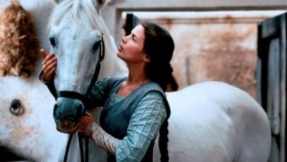
Julia Ormond’s Guinevere is updated to keep somewhat closer to modern feminist notions; in fact, Barbara D. Miller describes her as “a suspiciously feminist-seeming Guinevere, who excels at a kind of medieval soccer and actively participates in her own rescues” (157). While her dream of marriage, love and family is hardly revolutionary, Guinevere is also a proud queen and leader of her country. Her marriage to King Arthur is largely a political move to keep her country safe, and she maintains power over her lands even through her marriage. In one scene, as Malagant asks for rights over Leonnesse, which Guinevere technically rules, appealing to Arthur rather than an irate Guinevere, Arthur responds, “There’s your answer. She says no.” Women engaging so directly in politics hardly be in keeping with the times and the actions of the Middle Ages or King Arthur’s legends, but is well suited for our 21st century minds.
Contrastingly, Lancelot conforms to stereotypical notions of masculinity. John Aberth’s description of First Knight’s Lancelot does depict the masculine concepts of the Arthurian tradition: “The best Arthurian scholars can come up with to say is that First Knight is an allegory of a 1990’s-style conflicted male – Gere’s Lancelot – seeking masculine identity and fulfillment from an older role model – Connery’s Arthur – when besieged by a strong female type (17).
Aberth is absolutely correct in writing that this film depicts the search for “masculine identity” more than anything else. However, his claim that this is a masculinity of the 1990’s is worth further investigation. In fact, Lancelot’s masculinity fits well in with the original Arthurian legend, although the major plot points of the Arthurian legend are disregarded.
As discussed earlier, masculinity in the Arthurian legend revolves around women, warfare, and brotherhood. Lancelot, in our first view of him, is a mercenary of sorts, making his way through the world by demonstrating his prowess with a sword. The first time the camera pans over Gere’s Lancelot, he is in battle. From the beginning, viewers expect him to be physically able and strong. In the course of the conversation that occurs next, Lancelot espouses his life’s philosophy, which largely boils down to a way to fight:
MARK: Was that a trick?
LANCELOT: No, no trick. It’s the way I fight.
MARK: Could I do it? Tell me. I can learn.
LANCELOT: You have to study your opponent, how he moves, so you know what he’s going to do before he does it.
MARK: I can do that.
LANCELOT: You have to know that one moment in every fight where you win or lose and you have to know how to wait for it.
MARK: I can do that.
LANCELOT: And you have to not care whether you live or die.
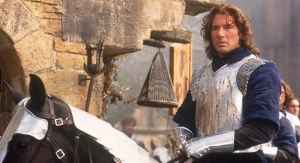
The large, strong Mark has no response for this last line. Lancelot is thereby set apart from the rest of the crowd in terms of physical prowess. His kind of invincibility complex is, from the start, a symbol of his masculinity.
Jacqueline Jenkins, in “First Knights and Common Men: Masculinity in American Arthurian Films,” contends that the masculinity Lancelot demonstrates is specifically America and relates back closely to the American Dream.However, the origins of Lancelot’s masculine trope are much earlier than America, and hail back at least as far as the Arthurian Legend. Jerry Zucker may have mangled the plot of the Arthurian legends, but his depiction of masculinity remains true to the themes portrayed by many medieval authors. Jenkins describes her masculine ideal as “physically powerful and aggressive and loving and considerate. All he needs is someone, a romantic love interest, to show him the way” (82-83). This masculine ideal is not born in the 1990’s, but revisited. The knights of Camelot depicted in the Middle Ages are equally physically powerful, and equally unmanned or ruled by women. The romantic love interests turn men from physical aggressors to love-lorn puppies, and First Knight clearly illustrates this tension. One glance and perhaps one conversation with Guinevere is enough for Gere’s Lancelot to change his mind about death.
The closest First Knight comes to achieving an iconic scene is the scene in which Lancelot runs the gauntlet to secure a kiss from Guinevere. Notably, Lancelot refuses armor or padding whilst attempting the gauntlet, rife with swinging pendulums and axes. The cries of the crowd that he will die if he attempts it on his own merits are ignored. Lancelot needs nothing but his own strength and wits to run the gauntlet. However, these same strengths and wits secure him a place at Camelot, the favor of King Arthur, and thereby, some very nice (if inappropriate for the supposed timeline) horses and armor. Material culture within the chivalric culture is an important indicator of status, and Lancelot eventually earns the best armor, swords, and eventually, title.
Of course, this gauntlet scene reveals more than simple accumulation of favor. After having run the gauntlet, Lancelot reprises his theory that he has no fear of death in a conversation with King Arthur. King Arthur, older and wiser, responds thusly, “Lancelot, just a thought. A man who fears nothing is a man who loves nothing; and if you love nothing, what joy is there in your life?” Over the course of the rest of the film, Lancelot falls in love with Guinevere. Like the Lancelot of Arthurian Legend, the best and brightest feats First Knight’s Lancelot accomplishes are in service of Queen Guinevere. While Ormond’s Guinevere can hardly be called a temptress or seductress, it is once more on her being that the fates of two men hinge. Her attractiveness is a constant temptation to Lancelot, torn between genuine admiration and honor towards Arthur and physical temptation in the form of Guinevere. In this manner, the relationship between men and women is still a product of a patriarchal society, echoing the same kind of relationships that are depicted in the Arthurian legend.
Monty Python and the Holy Grail: Medievalism at the Crossroads of Modernity
It may come as a surprise that the farcical and irreverent Monty Python and the Holy Grail is the film most esteemed by many medieval scholars. However, Terry Jones has created a masterpiece that not only satirizes the (inevitably modern) way we approach the Middle Ages, but also serves very well to juxtapose our preconceptions of the Middle Ages with modern realities. From the start, the Monty Python crew subverts our expectations. Instead of relating the more traditional (and romantic) love triangle tale of Guinevere, Arthur, and Lancelot, they focus on the Grail Quest. Of course, the omission of Guinevere herself is a gendered comment in and of itself, but Monty Python and the Holy Grail features a host of other, colorful women to engage men, for better or for worse. Moreover, the knights who seek the Holy Grail are satirical products of masculinity. Sir Lancelot in particular demonstrates the limitations of the portraits of masculinity held in the Arthurian legends and in our culture today.
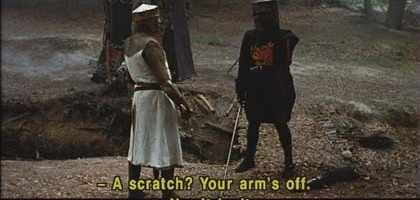
Monty Python and the Holy Grail makes no claims to historical accuracy, and therefore we need not concern ourselves with discussions of the sampling of historical events and myths that pop up inappropriately in Jones’s satire. Aspects from the Matter of Britain, the Matter of France, and the Matter of Rome (most prominently a reference to the Trojan Horse) appear in this film. Throughout, Lancelot is given great exposure – a dubious honor. In Arthurian tradition and contemporary imagination, as has been explored in this paper, Sir Lancelot is the ideal figure of knightly values and masculinity. In Monty Python and the Holy Grail, however, viewers have the distinct impression that Lancelot is trying a little too hard, perhaps compensating for something. In a notable scene, Lancelot ‘rescues’ Galahad from the Castle Anthrax, filled with scantily clad women.
LANCELOT: You were in great peril.
GALAHAD: I don’t think I was.
LANCELOT: Yes, you were. You were in terrible peril.
GALAHAD: Look, let me go back in there and face the peril.
LANCELOT: No, it’s too perilous.
GALAHAD: Look, it’s my duty as a knight to sample as much peril as I can.
LANCELOT: No, we’ve got to find the Holy Grail. Come on.
GALAHAD: Oh, let me have just a little bit of peril?
LANCELOT: No, it’s unhealthy.
GALAHAD: I bet you’re gay.
LANCELOT: Am not.
With notions of masculinity come equally notions of heterosexuality. Malory and Chretien de Troyes would not have even bothered to consider the possibility of a homosexual knight; as Ruth Mazo Karras states in “Knighthood, Compulsory Heterosexuality, and Sodomy,” “part of being a knight, in narrative convention if not in real life, was acquiring the love of elite women” (273). Part of acquiring the love of women, of course, necessitates a kind of sexual desire for women – a desire which this awkward interaction demonstrates Lancelot may not share. His hurried “Am not,” can very well be seen as a coverup. After all, failing to participate in the sexual community of knighthood that revolves around women would make Lancelot essentially ‘fail’ as a man. This tension is largely invisible in the Arthurian legends, as homosexual love is not particularly present. However, the Monty Python troupe makes clear the limits of the masculinity held dear in chivalric conditions – and their satire would be nowhere near as effective if it did not also mock beliefs we hold today.
Of course, there are physical dangers present as well in these knightly portraits of masculinity. As has been discussed, masculinity also requires brave deeds and physical prowess. Lancelot has certainly found his niche in this; he is known with an epithet of “the brave.” In an almost lackadaisical manner, Lancelot is credited with being the best with sword, the most virtuous, the most chivalrous and the most masculine knight that ever lived – matching Malory and Chretien in portraiture, and then exceeding past it. However, his epithet of “the brave” leaves little room for Lancelot to be anything but brave; his character is confined to braveness without depth. Sir Robin is the obvious foil to Lancelot’s derring-do, described in the film as “Sir Robin-the-not-quite-so-brave-as-Sir Lancelot … Who had nearly fought the Dragon of Angnor… Who nearly stood up to the vicious Chicken of Bristol… And who personally wet himself at the Battle of Badon Hill.” He never quite manages to succeed in his quests, preferring to run from the three-headed giant rather than face it. However, is fighting whomever one runs across in the woods a truly productive way to act? Although Robin may be deemed a coward, he is nonetheless a living coward, and his choice to disengage from combat, while cowardly in the Middle Ages, may very well be the choice many would make in his position.
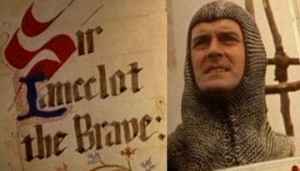
However slighting Sir Robin’s character may be, the best example of the ridiculous masculinity of Lancelot is perhaps a wedding sequence. While riding through the woods, Lancelot’s squire is struck with an arrow, bearing with it a message (in flowing, girlish script) that a person is being held against their will in a tower and being forced into marriage. Lancelot immediately hurries to the rescue, or rather, attempts to. Notably, Lancelot attempts to go on alone, as a hero should (and as the knights in Arthurian legends do.) He gives his squire a quick speech, and although the squire insists that he is well enough to travel, heads off on his ‘heroic’ journey alone. However, he is unexpectedly and unhappily surprised to find that the damsel in distress he has been seeking is no more than a very effeminate boy who seems determined to break out into dance and song. Embarrassed and confused, our overly masculine Lancelot is forced to confront his own gender binaries and stereotypes. Lancelot’s response to the effeminate Prince Herbert is to cut his ladder of bedsheets and thusly send the prince down to his death (although Prince Herbert miraculously survives.) As Donald L. Hoffman claims, “in this rough dismissal of the transgressive prince, the Pythons raise issues of cross-dressing and deviance, only to ruthlessly restore a brutal heteronormativity” (143). And, this heteronormativity is indeed brutal, as, upon breaching the castle, Lancelot fights his way through hordes of people, slaughtering the women, children, and soldiers alike in his quest. Fake blood abounds and the peaceful scene is utterly disrupted. On his way to the tower, Lancelot manages to kill the bride and her father. In this manner, we see that Lancelot’s masculinity is quite damaging and rather outdoes itself. Such slaughter and decapitation is painted as the natural end to Lancelot’s strict masculinity.
While in the Python crew’s dexterous hands, this scene is equal parts hilarious and ridiculous, it also hearkens fairly well back to legend. Lancelot many times slews great numbers of people in an attempt to rescue the damsel in distress. His fighting is expert, his physical prowess sublime and his respect toward women firmly in place. However, this form of masculinity, as the Monty Python crew articulates in this scene, works only in a very strict, fictional setting. In any real situation, this type of masculinity cannot work. Nonetheless, the scene is amusing largely because we recognize the masculinity of Lancelot as something we have romanticized for centuries.
Conclusion: The Men We Made
John Aberth writes the following in A Knight at the Movies, neatly demonstrating how film reflects culture:
“In nearly every case, filmmakers have altered history in order to make their movies, or so they believe, more meaningful and appealing to their audience. Therefore, even though the history may be wrong, the way it is presented in the film reflects, to at least some extent, the way in which modern audiences, filmmakers, and sometimes even historians wish to remember their past” (xi).
Aberth essentially makes the point that the differences between the traditional Arthurian legend and the more recent cinematic adaptations reveal the way society has changed. He argues that we look back with rose-colored glasses on the ages past, coloring them in a perfect shade of political correctness. However, equally important is that what has not changed between the tradition and today. The story has been re-appropriated and altered, the themes have been changed and the characters equally. However, masculinity has never been rehabilitated. Our romantic ideals of chivalrous knights physically fighting their way to rescue maidens or aid a common cause is largely untouched. The damsels are free to fight for themselves, but we’ve yet to allow the knights a chance to say no to battle, to preach peace over war, or be much more than a culmination of battle skills and sexual desires. The masculine ideal is as medieval as it is modern, and as limiting as any cage. Despite our great strides ‘forward,’ our culture remains looking backwards in terms of masculinity.
Works Cited
Aberth, John. A Knight at the Movies: Medieval History on Film. Routledge, New York (2003).
Cohen, Jeffrey Jerome. “Masoch/Lancelotism.” New Literary History, Vol. 28, No. 2. Medieval Studies (Spring 1997).
First Knight. Dir. Jerry Zucker. Columbia Pictures. 1995. Film.
Harty, Kevin J. “Cinema Arthuriana: An Overview.” Cinema Arthuriana ed. Kevin J. Harty, McFarland, London (2002).
Hoffman, Donald L. “Not Dead Yet: Monty Python and the Holy Grail in the Twenty-First Century.” Cinema Arthuriana. McFarland, London (2002).
Jenkins, Jacqueline. “First Knights and Common Men: Masculinity in American Arthurian Films.” King Arthur on Film: New Essays on Arthurian Cinema. ed. Kevin J. Harty, McFarland, Jefferson (1999).
Karras, Ruth Mazo. “Knighthood, Compulsory Heterosexuality, and Sodomy.” The Boswell Thesis: Essays on Christianity, Social Tolerance, and Homosexuality, ed. Mathew Kuefler. University of Chicago Press (2006).
Malory, Thomas. Morte D’Arthur. Ed. Charles Richard Sanders. Duke University, New York (1940).
Miller, Barbara D. “Cinemagicians: Movie Merlins of the 1980s and 1990s.” King Arthur on Film: New Essays on Arthurian Cinema, ed. Kevin J. Harty. McFarland, Jefferson (1999).
Monty Python and the Holy Grail. Dir. Terry Gilliam &Terry Jones. EMI Films. 1975. Film.
Parker, Kathleen. “A Little Bit of Chivalry Shouldn’t Hurt Anyone.” posttrib.suntimes.com. Accessed 20 March 2014.
What do you think? Leave a comment.











First Knight is not historically accurate AT ALL. Lancelot and Arthur were friends before Guenevere was introduced. In fact, Lancelot’s main goal in his life was to serve Arthur. Gere, along with a terrible script, rips apart the true, honorable man. Instead of a chivalrous knight we are given a scoundrel with a sword and a “good heart” (not to mention that accounts have described him as hideous). Lancelot would never fight for entertainment or money nor would he act as carefree. I really think this imposter Lancelot is a disgrace.
Malagant, I think I’ve once heard, is a minor villain in one of the tales. Mordred, Arthur’s illegitimate son with his sister, (I know, I know, read the story) is Arthur’s true foil. It’s understandable that introducing Mordred would mean a lot more backstory would have to be revealed, but to suggest that Malagant had enough power to even attempt overtaking Camelot and KILLING Arthur is ridiculous.
Major characters were barely acknowledged. It would have been nice to see some of the famous names acknowledged (Gawain – might have been named, Gareth, Agravain, Tristan, Percival, Morgan, etc.).
Everything about this adaptation irked me.
“Mordred, Arthur’s illegitimate son with his sister, (I know, I know, read the story) is Arthur’s true foil.”
There are also some versions where the discovery of the affair and Launcelot rescuing Guenevere from her execution is the start of the war that ultimately kills Arthur. But Modred is the generally accepted foil.
“Major characters were barely acknowledged. It would have been nice to see some of the famous names acknowledged (Gawain – might have been named, Gareth, Agravain, Tristan, Percival, Morgan, etc.).”
Gawain was named at some point during the film, but only in passing. Gareth and Agravain are listed as characters, but they aren’t acknowledged. I have a feeling that they acknowledged Gawain simply because he’s one of the more well-known amongst the general public.
it’s a good popcorn movie. I was a teen when it came out and I thought it was the greatest! !
I always felt that First Knight, just as jarvis says, was a great popcorn movie. Of course it isn’t “historically” accurate (though I’m assuming what you mean is canon, as the Arthurian legend isn’t grounded in any real history), or even particularly good as far as film goes. On the other hand, rather like the Kevin Costner version of Robin Hood, it is hilariously cheesy. Thanks for your thoughts!
Fantastic article!
I once took a class on Medievalism and Modernism in the Movies, and Monty Python and the Holy Grail, from a historian’s standpoint (not historical accuracy) is the most realistic interpretation of how we view Medieval history. It’s a patchwork of pseudo-facts and fantasy that we’ve passed down as truths. Such truths include the idea of the Arthurian castle with massive spires and towers that look more like the Disney castle than anything realistic.
Is there any correlation that you’ve seen between the modern constructions of medieval chivalry and masculinity, and the evolution of the action hero? If you consider the first true action hero (or as ESPN’s Bomani Jones calls it “The Impossible White Man”) to be Steve McQueen, are there similarities for how these two archetypes are treated?
I think there definitely is a correlation between our ‘superheroes’ today and medieval masculinity. I have to confess that my knowledge in this area is fairly limited, however. In my opinion, the idea of the ‘knight errant’ – a single, sometimes tragically so, man who fights alone with superhuman strength – is pretty much the same thing as our superheroes today. We expect them to largely forgo any serious relationships, fight alone, and follow somewhat archaic standards of morality.
I was wondering if you’re familiar with the recent BBC series, Merlin? While it takes a noticeably different (and not at all historically accurate) approach to the Arthurian legend, I found it refreshing for its lessening of the usual tropes.
For one thing, the main protagonist, being Merlin, is far from the masculine ideal. Merlin is unsure of himself, not physically strong or talented at fighting (expect magically), and is extremely awkward when faced with romantic situations. While it’s still fairly obvious he’s meant to be heterosexual, his sexuality and sexual prowess, or lack thereof, are never driving plot points.
Arthur starts out as a young prince, not yet king, in this series. His character is nearly a perfect example of masculinity, as you described in your article. He’s arrogant, excellent at fighting, and quite suave around the ladies. However, as the show progresses and Arthur grows up, all of these traits gradually change. He becomes much more humble, he realizes he is not the best or most talented fighter in the land, and he grows to love this show’s version of Guinevere (who is not white, for one thing, and is a servant), and loses basically all interest in the many swooning noble ladies who vie for his affection.
Of course, this show is far from perfect and has its fair share of typicality, but overall I feel it has definitely moved a step beyond movies such as First Knight and Monty Python.
Thanks for your article. It was a good, thought-provoking read!
I have started watching Merlin. (Got to love Netflix, right?) And I’m very much enjoying it. I find it very witty, funny, and definitely appreciate Merlin’s atypical heroic self.
Nice article.
Loved your section on Monty Python! I had never really thought about how it presented masculinity before this article.
it’s a good popcorn movie. I was a teen when it came out and I thought it was the greatest!
In college I read the chapter Le Morte d’Arthur in my Early British Lit class and I loved it. For years I had wanted to read the entire story and now I have. It was a wonderful read. I knew a lot about the Arthurian Legend before going into this book so at least I knew for the most part what was going on. All of the parts of the book were lovely though some times it felt that some of the chapters in certain books didn’t seem like they fit. Especially in the Tristram books. The book got annoying especially when other knights couldn’t recognize each other. But I suppose that would be common for having over one hundred knights in your companionship. But even the most common knights didn’t know each other and that’s what was really annoying. I was never a fan of Lancelot in the tales and even here I would get really annoying with him but I like how on his death bed he realized it was his selfish love of Gwenievre that Arthurs world fell apart. Interesting, I had never heard that before.
Elaine of Astolat’s death speech took my breath away.
I love the article! It’s fascinating how everything is a construct, but I never realized that Monty Python criticized this same point. Good work =]
This was a good article to delve into this morning, thank you for the intriguing approach to the topic.
Fantastic article! I find that I can never read too much about medieval things and I love your work.
I haven’t seen First Night in years, and I was always skeptical over the portrayal of Guinevere. However, after reading your article, I was glad to learn that she’s represented in a progressive manner (as you pointed out Arthur gives her a voice and maintains power over her country).
Read and shared. Good piece.
Thanks!
Cool piece. It’s funny to see how such a classic depiction of guys was created. I wonder what you make of newer productions like Game of Thrones that are set in a Medieval setting but are very gruesome in nature.
what i see from this article is the over-emphasize of how should masculinity and femininity should works in modern culture.
while its true that the view of knight are unchanged, still the same fight-or-die sense of living. the view of damsel-in-distress has changed….into the rather UN-realistic way
People, especially the westerners are too concerned with feminism movement’s view that they change what supposed to be fits to be a damsel-in-distress scene to be a woman who escapes on her own etc. while it is possible, a lot of them can be taken as being forced into the story. its as if weak women are not allowed in all kinds of story in this kind of age, its as if weak women should just be minor characters forever in all story in this kind of age.
i truthfully dislike society’s view of damsel in distress as a bad, weak thing just because feminism movement argues so. In real life, if a woman is taken captive by group of terrorist, she would definitely still asks for help. would you people blame her and ask her not to be a damsel-in-distress?
Yet there is a certain story i know, that portrays the female main character as distressed soldier who are confident, strong and beautiful. yet because she is considered too strong and too “egoistic” for her own goal, people hate her. from what i see, various story has emphasize women the need of “egoistical” thinking nowadays. which is actually fine for me
i’ve seen several not-so-man-ly main characters act only in a comedy story. i’ve seen several “serious” story with a meek male main character, and the reviews about them are mostly negative. its as if weak male are just clowns, not to be taken seriously and that being a main character on a serious atmosphere of a story is a bad ingredients. people brings out strong will with masculinity and even pride. while its true medieval masculinity did have those element, doesnt means it surely driven by masculinity alone. for example the picture above about a man having his arm’s cut off, he exclaim “dis but a scratch” it may be purely driven by his pride not because of masculinity. if the scene change into a woman having her arms’ cut off and exclaim she feels no pain as its just a scratch, would you people associate it with masculinity? i pretty sure the answer is NO
people are convinced the way masculinity and femininity shown nowadays is how it should be, no matter how un-realistic it is. especially women, just because how a woman is portrayed in the past being shown in the story,it will gained negative perception from the people even if it is realistic. nowadays not just feminism’s view of women, even people seems to think admitting yourself as straight and admit to dislike Homosexual is an insult beyond morals and they should be shamed. its as if being a heterosexual has become hidden shameful trait. seen several people wishing gay character to be added to a story and convinced it will be a good move, even though its unnecessary . Let me retract my words, “People are too convinced by how something should be nowadays in their own perspective”. Appreciation is nearing its end
And i am pretty sure a lot of people will disregard my post and feels like arguing after this….
Great work dissecting this topic! This reminds me a lot of the gender roles explored with Chaucer’s Wife of Bath character.